


CELESTIA presents over 100,000 stars you can "visit" in 3-D! Like our Sun (1.6.x), Proxima (1.6.x) and Naos (1.6.x).
Many stars exist as members of binary star "systems!" Like the binary systems of Kitalpha (1.6.x), β Tri (1.6.x) and 93 Leo (1.6.x).
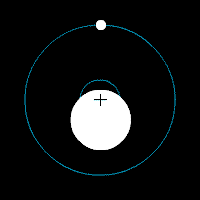
Triple and quadruple
stars are common too! Like Luyten 789-6 (1.6.x), Wolf 630 AB (1.6.x) and Gliese 896 (1.6.x).
Note: after running each link above in CELESTIA, Right Drag its window with your mouse to get a sense of the 3-D aspects of the stars and their orbits.
Are you unfamiliar with our 1.6.x and 1.4.1 links? For an explanation click here.
ORBITS OF
NON-SOLITARY STARS
Many stars exist not singly, but rather as components of multi-star systems. Here are a few examples of how they and their companions may mutually orbit each other.


Note that a pair of stars can be substituted for a single star in another system to form triple-stars, quadruple-stars and so on!

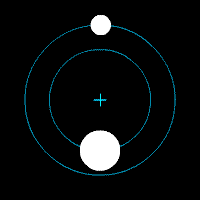
For example, the star that we know as Castor in the con- stellation Gemini is actually a 6-star system with quite dis- similar component stars and orbital geometries!
Here is the quite awesome Eclipsing Binary Simulator that lets you change param- eters of the orbiting bodies! You'll gain lots of insight and have loads of fun with this one! Notice how the bodies always stay balanced in their orbits—that is, on opposite sides of their center of mass —so the system's angular momentum is preserved.
Stars come in a variety
of colors, blue stars
exhibiting the highest surface temperatures!
CELES-TIPS
The following will help you enjoy this page's 1.6.x and 1.4.1 links that run events directly in CELESTIA. If you're new to the program, these tips will also help you learn to use it.
You'll find more information about many of CELESTIA's controls on our Learning Center page.
STELLAR OBJECTS
"Black Holes are among the most
mysterious of all stellar remnants."

Animation © SkyMarvels.com
derived from NASA/GSFC SVS animation.
PROTOSTARS, STARS & STELLAR REMNANTS
Stars are the mighty lampposts that light the Universe. In addition, they are the miraculous nuclear foundries that have fabricated the heavier elements that make all life as we know it possible.
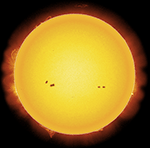 Our own Sun is a star—in fact, a rather ordinary one. Like all stars, it produces its prodigious energy through self-sustaining nuclear reactions. These proceed stably, depending on a star's type, from millions to billions of years.
Our own Sun is a star—in fact, a rather ordinary one. Like all stars, it produces its prodigious energy through self-sustaining nuclear reactions. These proceed stably, depending on a star's type, from millions to billions of years.
From NASA's CHANDRA X-Ray Observatory site, here are two posters that begin to acquaint you with Stellar Objects and their evolution. Stellar Evolution poster 1 Stellar Evolution poster 2.
NASA's "Life and Death of a Planetary System" likewise has a good introduction to how stars may form.
And from NASA's Imagine the Univers, here's a good page on Stars and Stellar Evolution.
PROTOSTARS
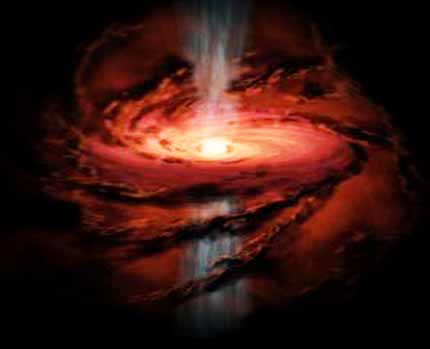
© SkyMarvels, enhancement of NASA/JPL-Caltech image
Protostars, the precursors of stars, are massive objects born from the gravitational collapse of immense clouds of interstellar gas and dust. Protostars represent the "toddler" phase of star development, which lasts only a tiny fraction of a star's overall age. For example, for a star with a mass similar to our Sun's, its phase as a protostar may last only 100,000 years.
Generally, protostars form in four major stages. "Early accretion" has been reached when a collapsing cloud of interstellar dust and gas has grown in density to become substantially less transparent to internal radiation. This causes its temperature to rise greatly. "Main accretion" is achieved when the protostar begins to outshine its enveloping donut of dust and gas. What has been called the "T-Tauri" stage proceeds when the protostar, finally enveloped by a flattening "protoplanetary disc" ![]()
![]() or "accretion disc", is radiating prodigious quantities of energy. Nonetheless, this is only the energy released by the cloud's gravitational collapse, for temperatures in the core of the protostar have not yet risen adequately to support the fusion of hydrogen nuclei. Eventually the "weak-line T-Tauri" stage is reached as the protostar continues to collapse substantially, and this cosmic lamppost is now destined to develop into a star of the main-sequence—in some tens of millions of years!
or "accretion disc", is radiating prodigious quantities of energy. Nonetheless, this is only the energy released by the cloud's gravitational collapse, for temperatures in the core of the protostar have not yet risen adequately to support the fusion of hydrogen nuclei. Eventually the "weak-line T-Tauri" stage is reached as the protostar continues to collapse substantially, and this cosmic lamppost is now destined to develop into a star of the main-sequence—in some tens of millions of years!
STARS
STAR CLASSIFICATION
Stars are incredibly massive objects that, for at least a portion of their lives, radiate prodigious quantities of energy produced through nuclear fusion. This colossal outflow is balanced by the relentless pull of each star's own gravity, which holds it in equilibrium for millions to billions of years. This imposes a predictable order on stars, which are most commonly classified according to their spectra and brightness, as shown in the venerable H-R diagram below.
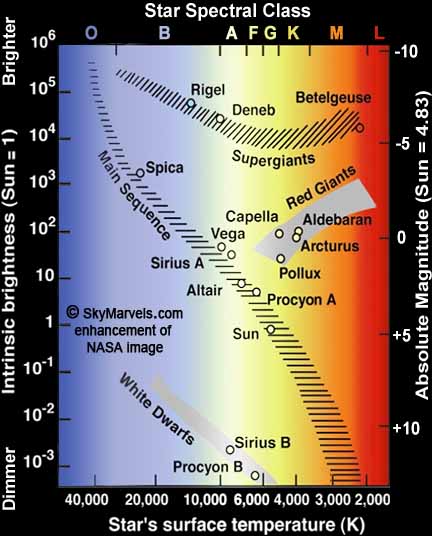
Wikipedia's Stellar Classification page
From UNL, here is an excellent HTML5 interactive H-R Diagram. Click anywhere to create a star. Then drag your star or the triangles on the graph axes. Awesome!
From the Las Cumbres Observatory, here's a fantastic interactive showing how a star's properties (mass, age, brightness) determine its location on the HR-diagram. Star in a Box: Interactive H-R Diagram.
Here's another excellent Interactive H-R Diagram.
And though they are a little slow to load, from ESA Science here are the intriguing and informative Gaia's Stellar Family Portrait and ESA Star Mapper.
Though the 100,000 Stars Google Chrome Experiment shows all our Solar System's planetary orbits in the same plane, it does show our nearest stars faithfully, and you can zoom out to the edge of the galaxy! Click on labels for more info on particular stars.
NASA/JPL's The Lives of Stars poster
List of Brightest Stars (apparent magnitude)
List of Most Luminous Stars (absolute magnitude)
List of Named Stars List of Nearest Stars
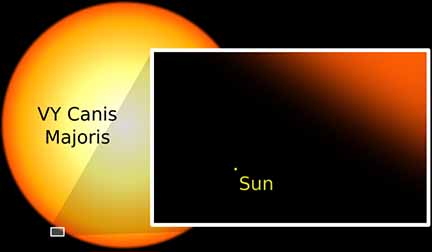
image credit: NASA
STAR SIZES
After seeing star-types like "supergiants", "giants" and "dwarfs" in the H-R diagram above, it should come as little surprise that stars come in a wide variety of sizes.
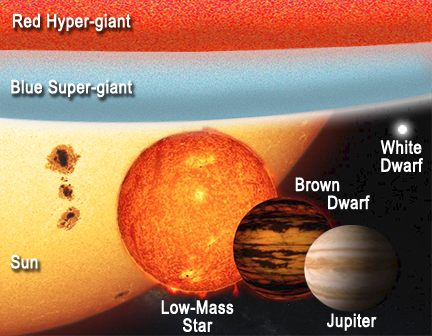
You can get a good idea of the relative size of the stellar realm with Nikon's extraordinary demo: UniverseScale.
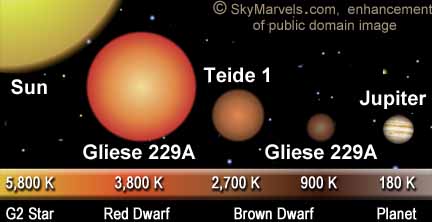
Another similarly awesome online tool that reveals the sizes of many types of stars is Scale of the Universe 2.
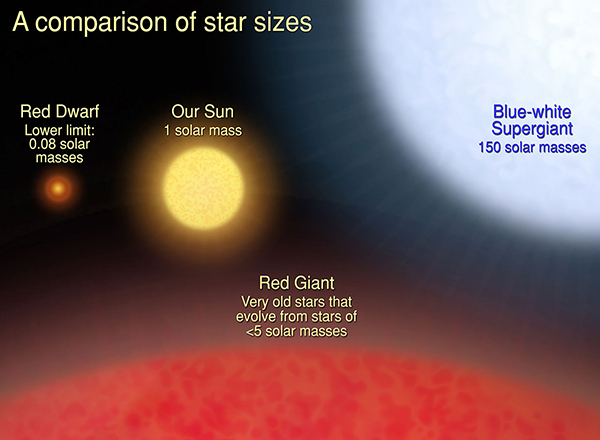
NUCLEAR FUSION IN STARS
For stars of roughly 1¼ solar masses and lower, the Proton-Proton (P-P) cycle ![]() is the primary way in
is the primary way in

which Hydrogen-1 ions (protons) are fused to yield helium and energy. The process involves several interactions of 6 overall protons, which ultimately yield one Helium-4 nucleus, two positrons, two gamma rays (energy), two neutrinos and two protons.
Here's an excellent Proton-Proton Cycle Interactive.
For stars of greater than roughly 1¼ solar masses, the Carbon-Nitrogen-Oxygen (C-N-O) cycle dominates in producing helium and energy from hydrogen ions (protons). This process involves several interactions of 4 overall protons along with a carbon-12 nucleus, the latter acting as a catalyst as it is converted to isotopes of nitrogen, oxygen and finally carbon-12 again.
In massive stars, heavier elements are progressively built-up in great shells around the core, resulting in a structure likened to the layers of an onion!.
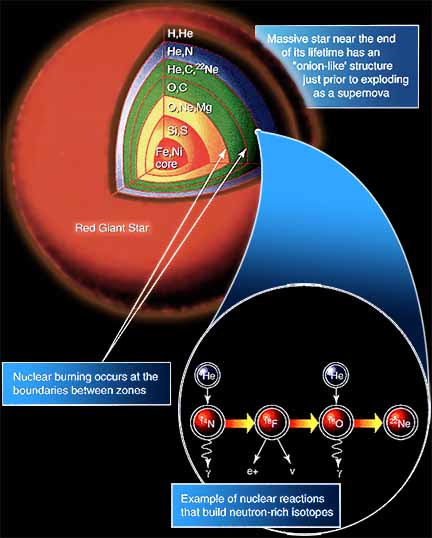
From HubbleSite Massive Stars: Engines of Creation is an excellent poster that shows build-up of layers in more massive stars and their eventual supernova stage.
MORE INTERESTING STAR LINKS
Wikipedia pages: Star, Stellar Classification, Stellar Nucleosynthesis, Binary Star, Star System.
NASA Science: Astrophysics: Stars.
NASA: Herschel Space Observatory: Stars.
STELLAR REMNANTS
WHITE & BLACK DWARFS, NOVAE & SUPERNOVAE, NEUTRON STARS,
QUARK STARS AND BLACK HOLES
All stars eventually succumb to natural processes and "die". They go through a process of expansions and contractions, shed a percentage of their outer layers, and undergo a final collapse. But this does not occur in the same way for all stars.

 By far, most stars (perhaps 95% or more) approach their final stages as white dwarfs! These are fantastically dense objects. Roughly Earth-sized, a typical white dwarf may still be half as massive as the Sun! This means that one is so dense that a white dwarf's gravity can noticeably bend the light of stars passing behind it!
By far, most stars (perhaps 95% or more) approach their final stages as white dwarfs! These are fantastically dense objects. Roughly Earth-sized, a typical white dwarf may still be half as massive as the Sun! This means that one is so dense that a white dwarf's gravity can noticeably bend the light of stars passing behind it! ![]() Nonetheless, at this stage it can no longer radiate any energy through fusion, but only by virtue of its final contraction. Eventially it will cool to become a black dwarf, though not for an incredibly long time. In fact, astronomers now estimate that the Universe is not yet old enough to have produced any black dwarfs! Here are Wikipedia's White Dwarf and Black Dwarf pages.
Nonetheless, at this stage it can no longer radiate any energy through fusion, but only by virtue of its final contraction. Eventially it will cool to become a black dwarf, though not for an incredibly long time. In fact, astronomers now estimate that the Universe is not yet old enough to have produced any black dwarfs! Here are Wikipedia's White Dwarf and Black Dwarf pages.
Some stars approach their final stages with a series of explosions (novae) or a single devastating explosion (supernovae). These return great amounts of matter back to the interstellar medium, matter that eventually contributes to the immense clouds that may one day spawn other stars. From the University of Arizona's astronomy site, here's a nice page highlighting Novae and Supernovae. From NASA/Conceptual Image Lab at the Goddard Space Flight Center, here are nice ani- mations depicting V407 Cygni "Going Nova" and a Type Ia Supernova". Also from NASA is the high-reso- lution A Guide to Supernovae ![]() . And here are Wikipedia's Nova and Supernova pages.
. And here are Wikipedia's Nova and Supernova pages.
When a star's final collapse yields an object of between 1.4 and 3.2 solar masses, its gravity becomes sufficient to literally squeeze its electrons into its atomic nuclei! This yields a neutron star, an object with a diameter of roughly 12 miles (20 km) but a mass that's greater than that of our Solar System! Ranking among the most exotic objects in the universe, neutron stars can take several forms, as these next images and animations from NASA show. One may simply be a single pulsar, or may be a pulsar drawing matter from a much larger companion, which can generate strong gravitational waves! Or it may also be a magnetar, a neutron star with an incredibly strong magnetic field. It has even been theorized that in some cases there are Binary Neutron Stars That Merge! Here are links to NASA's Imagine the Universe: Neutron Stars and Pulsars and Neutron Stars, Pulsars and Magnetars pages. And here are Wikipedia's Neutron Star, Pulsar, and Magnetar pages.
It has been theorized that there may be objects that are too massive to remain neutron stars, yet not massive enough to become black holes. These objects are quark stars, whose gravity is sufficient to disassociate its neutrons' "bound quarks" into "free quarks!" Quark stars would not be much smaller than neutron stars, as this intriguing comparison from Chandra's site shows: A Neutron Star and Quark Star in the Grand Canyon! But it must be stressed that this comparison is only illustrative of relative sizes. If a neutron star and quark star were ever so near to us, Earth would have already been destroyed by their gravity! Here is Wikipedia's Quark Star page.
With black holes we reach the "end of the line" of our stellar remnants! When stars of a sufficient mass eventually collapse, their gravity is so powerful that nothing, not even light, can escape from them! They may even become Star Eaters! ![]()
Wikipedia's Black Holes page.
UCLA Galactic Center Group's
Stars Orbiting MWs Supermassive Black Hole
![]()
ESA's Black Hole Visualization Tool
![]()
cK-12's Does A Black Hole Bend Time?
Home Intro News Gallery Sky-Gifts Bonuses Tips
Learning Ctr Help Links Credits Legal Contact Us
© 2007-
by Gary M. Winter. All rights reserved.
Interested in political cartoons and humor?
Check out The HIPPLOMATS™.
SkyMarvels, Sky Marvels, SkyMarvels.com, STELLAR OBJECTS! Stars, Pulsars and Black Holes. celestia4all, celestiaforall, CELESTIA, astronomy, space, simulations, animations, downloadable astronomy posters, stars, planets, Inner Planets, Outer Planets, Inferior Planets, Superior Planets, moons, asteroids, comets, Oort Cloud, galaxy, galaxies, Milky Way, Andromeda, globular clusters, binaries, quasars, black holes, supermassive black holes, telescope, telescopes, planetarium, software, freestuff, satellites, add-ons, addons, scripts, eclipses, Solar Eclipses, Lunar Eclipses, Solar Eclipse Finder, Lunar Eclipse Finder, mutual eclipses, transits, occultations, Solar System, CELES-TOOLS, celeSTARrium, CELX, CELX programming, Freebies, Bonuses, multiple views, atronomical unit, light year, parsec, meteors, meteor showers, Perseids, Geminids, Leonids, barycenter, time, Time Zones, tides, alignments, conjunctions, oppositions, seasons, apogees, perigees, aphelion, perihelion, Earth, Luna, Mercury, Venus, Mars, Jupiter, Galilean Moons, Io, Europa, Ganymede, Callisto, Saturn, Titan, rings, Uranus, Neptune, Triton, E-MSpectrum, electromagnetic spectrum, astronaut, equinoxes, solstices, precession, rotation, spin, inclination, tilt, Ecliptic, orbits, ellipse, parabola, hyperbola
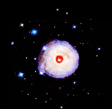
Animation © SkyMarvels.com
derived from NASA images.
Donate safely with: PayPal
and receive one or more
Sky-Gifts. Your support is greatly appreciated!
NOTE: you do not need a PayPal account to donate.
SKY VIEWING
SOLAR SYSTEM
THE SUN
MERCURY
VENUS
EARTH
THE MOON
MARS
JUPITER
SATURN
URANUS
NEPTUNE
SMALLER WORLDS
STELLAR OBJECTS
EXOPLANETS
DEEP-SKY OBJECTS
SCALE OF THE COSMOS
———————
SKY-FUN / SKY-GAMES
FUN FACTS ABOUT
STELLAR OBJECTS
Virtually all elements heavier than hydrogen and helium were produced in stars!
Well over 2/3 of all stars are dim red dwarfs! In addition, most of these are single or "unary" stars, (that is, they have no companion stars!)
In our galaxy the average distance between stars is about five light years!
Most "bright" stars exist as components of binary or multiple star systems!
According to some experts, the Universe is not yet old enough to have produced any black dwarfs!
Because gravity so greatly "bends" the light radiated from a neutron star, more than 2/3 of its surface is simultaneously visible to an observer! If the same were true on Earth, an observer in geosynchronous orbit could see ALL of the Antarctic and the Arctic at the same time!
Scientists now theorize that "quark" stars exist! A quark star is more dense than a neutron star but not dense enough to become a black hole!
The more massive a star, the shorter its lifespan!
Some "type-O" high-mass stars remain on the main sequence for only 500,000 years, while some "type-M" low-mass stars remain on it for over 75 BILLION years!
STELLAR OBJECTS INTERACTIVES
QUICK ACCESS LIST
Note: some links are echoed elsewhere on this page and may include descriptive text. Note too that there are a few links to interactives in the center column immediately next to this list, so they are not duplicated here.
Interactive H-R Diagrams:
#1 #2 #3
Gaia's Stellar Family Portrait and ESA Star Mapper from ESA (very slow loading)
VIGOR Binary Black Hole Simulator
NASA's CHANDRA Site's Stellar Evolution
SKYMARVELS™
CELESTIA ADD-ONS
SKYMARVELS™ POSTERS
SKYMARVELS™ VIDEOS
Solar Eclipses:
Lunar Eclipses:
Moon's Occultation of Venus 2010 May 16
Moon's Occultation of Venus 2010 Sep 11
The Same Side of the Moon Always Faces Earth